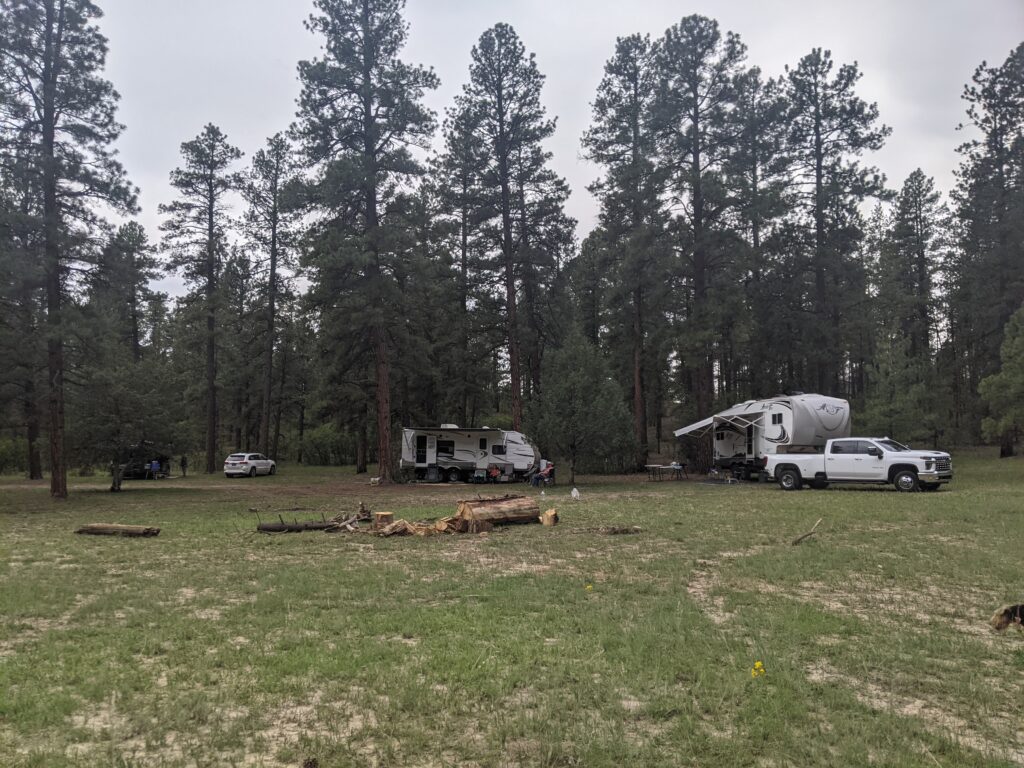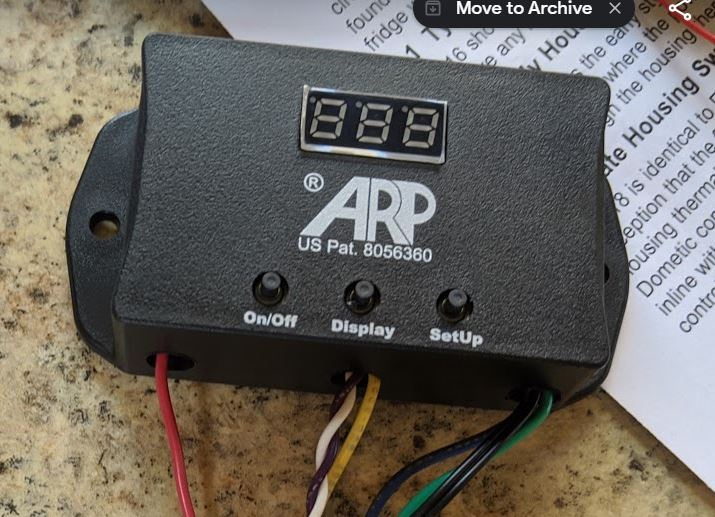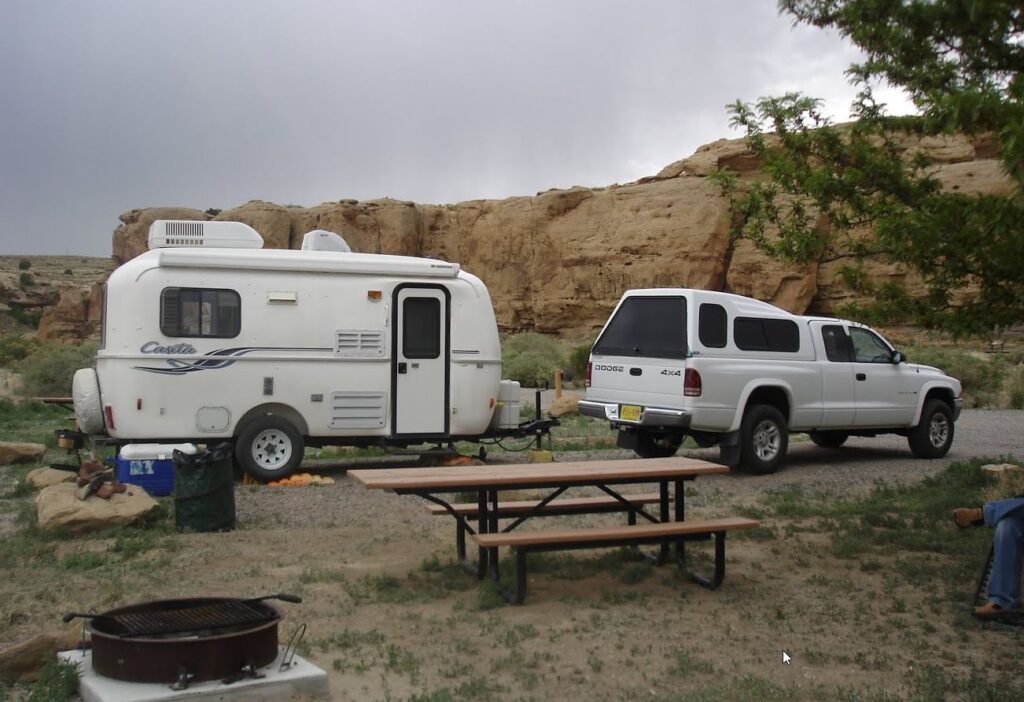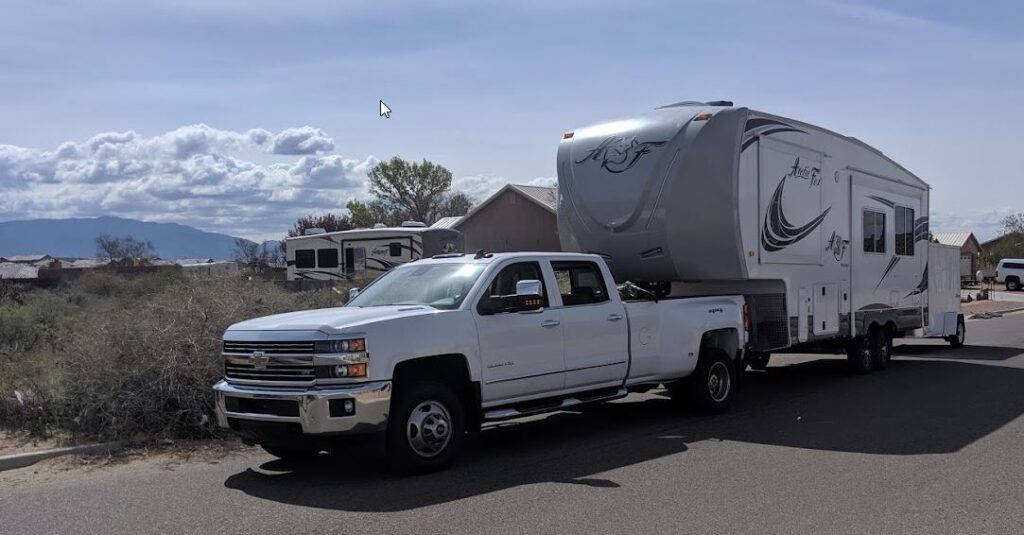There are a few subjects in the RV camping world that cause people dread. First is probably dealing with the black tank, but I’d suspect the thought of camping without hook-ups is easily in the top 5 for the folks that haven’t done it. In this Intro to Boondocking we will go over the basics of how you can boondock successfully and have a great time doing it.
I think it’s really important to say here – no amount of planning is perfect. In camping with an RV, there are very likely going to be glitches and gotcha’s that will put a minor kink in your plans. But none of that is critical – what is critical is that you get out there and have a GREAT time! Use what we have here as a guide, but don’t stress…..as my mom loves to say….
“Don’t sweat the small stuff”
For the purposes of this article, we will be talking temperate weather camping, say 30F to 100F. We you get much beyond that, especially on the cold side, there are a lot more considerations to take into account.
What is Boondocking?
Boondocking can mean different things to different folks. From a rustic National Forest campground with no hookups, overnighting in Cracker Barrel parking lot or just finding a meadow out in our countries plentiful public lands, Boondocking can take on a different meaning to different folks, For the purposes of this article, Boondocking is defined as “Camping in an RV with no water, sewer or electrical hookup”. IE: using your campers “fully self-contained” functionality.
So whether you are in a beautiful Harvest Hosts sipping a glass of wine, or just experimenting in your own driveway, if you are not connected to shore based water, sewer or electricity, it is Boondocking.
This article will have useful information for anyone who wants to boondock and is focused on the casual Boondocker. Going out for days or maybe even a couple of weeks.
Why Boondock?
My darling bride and I probably Boondock 70%+ of the time. Sometimes just a quick weekend alone in a large meadow surrounded by Ponderosa Pines in the cool high mountains of Santa Fe National Forest, sometimes sitting in on my sisters property visiting with family. For us camping is more about getting away from the hustle and bustle of life in the suburbs and instead finding a peaceful place to relax in nature.
Another great use is as overnight stops on the way during a longer trip and spending the night in a rest area or Walmart parking lot.
Whatever your motivation is to boondock, having the flexibility to not have to worry about hookups is freeing and opens up TONs of camping options outside of the traditional RV parks and campsites with utilities.
What is different about Boondocking
It is all about resource management. When you are connected to full shore hookup, you have unlimited electricity and water as well as a way to empty an unlimited amount of waste water. When you Boondock, all your water and electricity come in with you and you haul all your waste water away. So Boondocking you are fully self-contained for your resources.
There are camping locations that may have 1 or 2 of the 3 typical RV hookups, say electricity and water, but no dumping at the campsite. These are partial Boondocking and just use the sections that apply.
The Resources
This is going to be written for folks that spend days off the grid, not multiple weeks or months. That is a whole different conversation that I may go into in a future article. The concepts are the same, it is more about how you go about refreshing resources when you are out there for weeks on end.
Propane
When you are boondocking you are going to want to save battery power and run your high draw appliances (Fridge, Hot Water) off of propane. While you do need to keep an eye on the amount of propane you have, it’s energy density means it rarely becomes the constraining resource. In all but the coldest weather, a single BBQ sized 20lb tank will easily provide you lots of hot water, refrigeration and heat for a few weeks.
Water and Tanks (fresh and waste)
Using the water system off the grid is really all about “What goes in, must come out.” If you’re new to campers, you may want to review The Basics on camper plumbing systems before reading on.
Beginners guide to RV Campers water and plumbing
Tank Sizes
Most campers have a pretty good balance between how much fresh water it can hold and how much of the Grey and Black water tanks can hold. The Grey water tanks should be bigger for sure – think showers and dishes vs how much water goes down the toilet. In our Casita (our first camper) we had 25 gallons of fresh, 30 gallons of grey and only 8 gallons of black. This actually worked out well and while the black did fill up first, by then we were typically out of fresh water anyway.
Our current Arctic Fox has very generous and well proportioned tank sizes with 80 gallons of fresh, 35 gallons in the galley and 67 gallons for the shower and 65 gallons for black. We have Boondocked for 10 days without conserving “tooo” much and just made it without running out of fresh. Haven’t ever filled up any of the waste tanks.
There is no ideal ratio of tank sizes – everyone uses their water in different ways and thus have different requirements. But for Boondocking there is no doubt that more is better, and having them be somewhat proportional can help a lot. (It would not be that useful to have 100 gallons of fresh, but only 20 of grey or 10 of black)
Water Conservation
There are a lot of tricks you can use to conserve water, and some people are so good at it that they can go weeks on modest amounts of fresh water. We typically aren’t camping for extended periods of time so we aren’t that conservative with our water use. We have more than most and often go a 3 day weekend without conserving at all – full showers etc. The longer we are going to stretch out the trip, the more conservative we become on water usage.
Showers
First – if your shower did not come with a shutoff valve that allows you to turn off the shower without messing up the temperature setting then install one. This is the one I installed in the Fox,
We get the water temp adjusted as quickly as possible and hop right in. Quickly soak yourself down and then shut off the water. Now you can soap & shampoo up without water going down the drain. Then of course turn the water back on and rinse. Easy.
The more conservative folks will get a bucket or tub and catch the warm up water. They can then use that water for other purposes such as flushing the toilet.
Some go even farther and use something like wet wipes to clean the stinky bits, extending how often they need a full shower.
Dishes
Another area you can use up a lot of water. We plug the sink and have a soapy rag, then start the water. While the sink is filling we are washing and putting aside. Usually starting with the smaller dishes. Generally there is about an inch in the sink when the little stuff is done. We then run the water to rise the little dishes, still into the sink, increasing water level. Just continue this process, and as you near the end and get to the big stuff you’ll have enough water for soaking or cleaning those big guys.
All that said, me almost always use paper and plastic for utensils.
Some folks put a plastic tub in the sink – catching the water making it usable for other things like flushing. Others use various wipes and other techniques that honestly sounded to me like more pain than it is worth.
Toilet
Not a lot to do here to save. You do want to use plenty of water for #2 – every time. I typically fill the bowl about 1/2 way. #1 is easy and just work the pedal/lever fast and use very little water.
But as mentioned above, you can use water from other sources to flush or fill the bowl.
Drinking
MANY people do not drink from the taps on their camper. I’m not one of those and do it all the time. We have a very good well at home and I know I have sanitized my tanks for every season. From the conservation perspective, if you drink camper water or bottled or jugged or whatever, you are still drinking what you brough with you. There isn’t much conservation, everyone needs to drink water!
Again, for cooking things like pasta – you can capture the water when you strain it and use for flushing or even to do the dishes.
Waste Water Disposal
Not a lot to do here, you don’t want to be dumping waste water (Gray or Black) ANYWHERE except an appropriate sewer connection. If I’m out in the boonies, I do usually pee outside <wink>!
Just keep in mind, generally, the more water you use, the more water ends up in your tanks and the sooner you’ll be forced to break camp and go dump.
If you are camping in a campground that has a centralized dumping station, some people will use a device to transfer waste, but personally I haven’t found the need.
Electrical Systems
This is important. If you run out of 12V electricity, all of the advanced features of your rig are dead. No water. No lights. No heat. No refrigerator. No furnace. No slides. You are down to basically a hard sided tent. I’ve been there – it’s not the end of the world, but sure does take away a lot of the reasons we like boondocking in a camper.
If you haven’t already, you should click the below picture for a basic understanding the electrical systems in a typical camper
Beginners Guide to RV Camper Electrical Systems
For the our purposes today, we will be focusing heavily on the left side of the above diagram and things we can do to extend our time off the grid without supplemental sources like solar or generators. We will touch on replenishment, but not the focus.
Remember that when you are boondocking, your high “power” draw items will be running from propane. This is due to the density of energy in propane vs batteries. Things like the hot water heater and refrigerator will run on propane as the primary energy source. But that does not mean they don’t need 12V power as 12V power runs their control circuits so if the batteries are dead, they will not run either.
If you need to run high power loads like the AC, hair dryers, etc. the easiest solution is a generator. If you have a big enough battery bank you can run some of those things for a short period of time. For most folks a generator is going to be more practical
Batteries
The heart of any RV electrical system. Batteries store 12V DC electrical power and make it available for use by the various systems in your RV. There are two primary types in an RV – Lead Acid and Lithium Iron Phosphate (LiFePO4 or just Lithium). Lead Acid is broken down into flooded cells and Absorbent Glass Mat (AGM). There are pros and cons to all of these, with Lithium making a lot of headway in recent years.
For more details on batteries and battery selection see our RV Batteries article.
Capacity Planning
No matter the types of batteries being used, our end goal is to consume as few Amp Hours (Ah) as possible and to have the largest Ah bank possible. Think of an Ah as a gallon of electricity – we have a limited supply and want to use each one in the best way possible..
In our batteries, available Amp Hours (Ah) are what we need and want. The Ah number correlates to how many hours the battery can run a 1 amp load. A typical RV incandescent light bulb pulls 1 amp, so if your battery has 50 Ah, that battery could run that bulb for 50ish hours. The end goal is to fit as many available Amp Hours (Ah) as possible into the space and weight constraints available. Of course cost comes into play as well.
Some folks on the internet expect you to “know” what you will use. Not really possible, but the concept of what systems in your RV use the most power is very helpful. How much power you consume will vary on every single trip depending on things like outside temp, activities, etc.
Kyle’s Usage Calculations
So to figure this out we need to look at how amps each of the items in our RV consume. Remember that if any one of these runs for an hour, that amp number is also how many Ah it pulled from our battery during that hour. Ah = Amps * Hours.
The idea here is to minimize how much power you draw off the batteries in order the extend the amount of time you can stay off the grid. If ya need to dig into your specific usage, hop on over to the Member Community where we’d be glad to help.

I currently use Flooded Lead Acid batteries. There are 2x6V Golf Cart batteries wired in series to give me 225aH of capacity at 12V. Remember with lead acid batteries you really want to try not to go below 50% capacity for longest battery life and going below 80% has a serious impact on the life of the battery. That means I shouldn’t draw my batteries down more than 112Ah before recharging.
To gather real world data, I went to the camper, turned off the solar and my converter and then used my BMV-712 to see how many amps each device was drawing from the batteries in real-time. The Hours / Day column is a rough estimate and obviously varies.
Yikes – it looks like I’m over doing it a bit. BUT – I have 400W of solar that in good conditions completely recharges my batteries to 100%, usually by noon.
This usage is highly variable. That beer cooler, while I love it, pulls the MOST power and is optional. Many trips we don’t use the furnace or TV/Inverter/Radio at all.
Some campers now days are coming standard with Residential or DC powered compressor refrigerators. You see what my DC powered fridge draws and a residential fridge is considerably worse. They just aren’t boondocking friendly and will requires you to replenish your batteries more often via Solar or a Generator. Type and use of RV Refrigerators.
I have setup out in the forest where I was turned around a bit and misjudged where the suns path would be during the day. We ended up in almost full shade all day long under beautiful Ponderosa Pines. I had to turn off my beloved beer cooler for most of the weekend and we did just fine. (Remember – Don’t Sweat the Small Stuff!)

Here I turned off all the optional items, IE: running lean. I could easily go 5 days with no solar running like this before I’d get to 50% discharged on my battery bank.
Estimate Your Own Usage
First thing to do is figure out the size of your battery bank. Most RV’s come with a single “marine” style battery that will have 60-80 Ah’s of capacity. Figuring 50% desired maximum battery draw down, that only gives you 30-40 Ah’s of usable power. As you can see from the picture above, most people who are being conservative in power usage are going to pull 20ish Ah / day. Giving you basically a weekend of use before you need to recharge.
I made the above spreadsheet so you can download it and modify as appropriate for you to guesstimate how much power you will consume. You can google the various things you want to run and see how much power they draw.
If you see Watts on an AC powered device that you will run from an inverter here is the formula to get to 12V amps.
Watts / 12V = AMPS Then add about 20% for inverter losses.
Summary
As you can see, it is all about resource conservation. For my wife and I as well as a lot of other people, Boondocking greatly expands our enjoyment of camping and the great outdoors. Living in beautiful New Mexico there are vast tracks of public land available for us to explore. By managing our resources we can greatly extend how long we can stay off the grid and away from civilization on our camping adventures.
If you want to dig in more on Battery types, usage and how you can maximize your capacity More on recharging options like Solar and Generators?….stay tuned! But in the meantime, if you need help jump over into the Member Community and we’ll get ya going!






